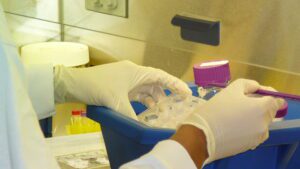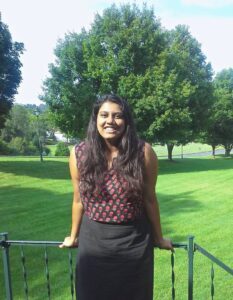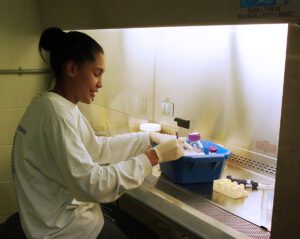Science faculty saw a surge in student research on campus this summer with projects covering a range of scientific disciplines and including some with interdisciplinary collaboration.
Biochemistry student Zindzi Thompson ’18, psychology students Sharanya Rao ’17 and Elise Ball ’17, physics student Anna Wright ’17, and biology student Shelby Ma ’17 participated in the research opportunities in Pearce Science Center. The research was made possible, in part, by funding from the Mary Baldwin Summer Fellows program, the Virginia Foundation for Independent Colleges, and the American Society of Biochemistry and Molecular Biology.
Physics students worked with psychology students to compare the behavior of nanoelectronic memristors — small, flexible electronic chips that retain memory without power — with neurological functioning in the brain. A better understanding of the physics behind how memristors work could eventually revolutionize technologies such as artificial intelligence and computing.
“This work helped us to explore parallels between computer circuitry and biological functions and to gain insight into the limitations of our current models,” said Associate Professor of Physics Nadine Gergel-Hackett.
Wright said she believes the research experience will give her a leg up when applying to graduate schools, and eventually, in the job market. The Harrisonburg resident is a student in Baldwin Online and Adult Programs and the mother of two children, ages 10 and 12. Her major is applied mathematics with a minor in physics and business. Next year, Wright hopes to be in graduate school studying engineering.

“This experience has given me an understanding of how scientific research goes — slow with sudden breakthroughs — and the confidence to speak up and offer input and suggestions,” Wright said. “To work side-by-side with professors was a great experience as well.”
Working on the psychology arm of the research project combining physics and neuroscience was Ball and Rao.
An international student from Mysore, India, Rao is in the Mary Baldwin College for Women majoring in psychology with an emphasis in mental health and a double minor in women’s studies and art history.
“We attempted to create a circuit with memristors that ‘learned’ like neurons and neural pathways do,” Rao said. “Mathematically, we were able to re-create the process of sensitization using memristors in the circuits. The project, on the psychology side of things, consisted of a lot of research into the workings of neurons and neural pathways and brainstorming on how to reconcile the physics with the biology.”
Rao is applying to PhD programs in clinical psychology that work on the Boulder model, which places equal emphasis on research and applied clinical training. She said she wants to conduct cross-cultural research — particularly concerning minority and under-represented populations — and has already begun working on this goal through her undergraduate thesis.
“I learned a great deal about the strengths of collaboration and the significance of interdisciplinary research through this project,” she added. “Each side contributed new or different perspectives and questions, and it made for a stronger project overall. I definitely want to apply this approach to research in my career.”
Summer research like the kind conducted by pre-med student Thompson, “makes students stronger candidates for employment in the biotechnology or pharmaceutical industries and for acceptance to graduate school in their area of study or to medical school programs,” said Maria Craig, associate professor of chemistry.

Thompson and Craig worked to develop a consistent method of detecting LL-37 — an antimicrobial peptide that is active in the innate immune system — and to determine whether adding Vitamin D to model white blood cells induced the production of LL-37. Among the peptide’s many functions is its role in the development of autoimmune diseases.
“This summer I became more familiar with lab work in general through various techniques like the Dot Blot Antibody Test, Western Blot, and counting cells with a hemocytometer,” Thompson said. “Along with these techniques, I learned more about molecular immunology and its applications in the medical field.”
Thompson is conducting further experiments this year using the information that she learned over the summer. “Next year,” she said, “I plan to continue this research project as my senior thesis.”
“Zindzi was a wonderful student to work with,” Craig said. “She was interested in the research project and showed a natural aptitude for lab work. My research students, including those who work during the summer, perform individual projects related to the research area of my laboratory. Each student project adds new information that serves to advance the research.”